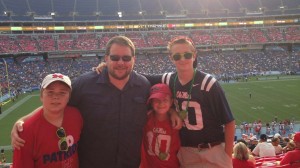Jeremy Rice has lots to smile about these days.
Enjoying his 15th year in the U.S. Army, the University of Mississippi civil engineering alumnus leads the Mechanics Group within the Army Propulsion Lab, a branch of the Aviation and Missile Research, Development and Engineering Center at the Redstone Arsenal. He also recently finished his doctorate in mechanical and aerospace engineering at the University of Alabama in Huntsville, where he and his family reside.
“It was a good situation,” said the Paris, Tennessee, native. “I was able to perform my doctoral research at the Army Propulsion Laboratories as a part of my official work duties. I completed my dissertation and degree in the spring of 2014.”
Rice came to Ole Miss after his high school chamber singers’ director recommended that he consider enrolling here. During a visit to campus in the spring of his senior year, he was absolutely blown away.
“I attended Ole Miss on an academic scholarship for tuition and books, and performed in the university’s Concert Singers and the Opera Theatre in order to pay my out-of-state tuition,” Rice said. “I completed my B.S. in Civil Engineering in 1997 and my M.S. in Engineering Science in 1999.”
Before going to work for the military, Rice was a graduate assistant in the Department of Civil Engineering. While he has many great memories from his years in the School of Engineering, Rice said four professors had a huge impact upon him.
“Dr. M.S. Abdulrahman had a particular way of making subjects like structural analysis and steel design interesting and entertaining,” Rice said. “When I think of my undergraduate years, he really stands out in my memory.”
Rice worked with Waheed Uddin as a teaching assistant for computer-aided design, and as a side project performed his very first material constitutive modeling work on an early pavement model of Uddin’s.
“I was slacking a little bit, and Dr. Uddin called me into his office after class and really called me out on my level of effort,” he said. “Looking back, he did that exactly at the right time, and it had a big effect on me and my future academic career.”
An “a-ha moment” came for Rice during an afternoon laboratory session with a new professor.
“Dr. Chris Mullen came in and demonstrated to us how you could predict stress fields using a technique called finite elements,” he said. “I had never heard of finite elements before that time, but left class that afternoon with a certainty that I wanted to learn that technique.”
Rice worked with Mullen as a research assistant throughout his tenure as a graduate student. Mullen had a large FEMA grant to evaluate the effects of a large earthquake upon campus buildings. Rice was one of several graduate students who worked with him on the project.
“I was able to develop valuable modeling and simulation skills, and got to see a lot more of the buildings on campus than most students,” Rice said. “I think I took every class that Dr. Mullen offered in those days, and still use that material every day in my professional career.”
The faculty member whom Rice credits with having the most lasting impact was Robert Hackett.
“Dr. Hackett helped me get my foot in the door in Huntsville by helping me to secure my first interview,” he said. “Several years later, we crossed paths again and had the opportunity to collaborate on some material modeling efforts of composite materials. This work led to my Ph.D. research, during which Dr. Hackett was a most valuable resource. I can definitely say that my collaborations with Dr. Hackett have been some of the most important throughout my professional career.”
The most fulfilling aspect of Rice’s work is seeing a project, to which he has made some contribution, transition into active service and help protect the young men and women serving in the Army.
“The greatest professional honors for me all seem to deal with some sort of writings,” he said. “I was awfully excited to get my first professional journal publication in the Journal of Applied Physics. Several years later, I was very excited to get my first publication outside of my primary field of expertise in the Journal of Combustion and Flame.”
Rice was asked to author several NATO mechanical property test standards, which are used in laboratories around the world. Recently, he was recruited to contribute a book chapter into an AIAA textbook on rocket motor mechanical design.
“A couple of times I have been asked to serve as the chairman for the Joint Army, Navy, NASA, Air Force Joint Propulsion Meeting, most recently in Washington D.C.,” Rice said. “This is a big annual technical meeting of rocket propulsion experts from the joint services, NASA, industry and academia, and is a big honor in our field.”
Rice married his college sweetheart, Jennifer, who also graduated from Ole Miss in 1997 with a degree in English. The couple has three sons: Elijah, 14, William, 12, and Joshua, 9; and a daughter, Ansley, 7. All four children are big Rebels and plan to attend Ole Miss.
A self-proclaimed outdoorsman, Rice and all of his children are very much into Scouting programs.
“We do a lot of camping, hiking, canoeing/kayaking and fishing as a family,” he said. “It also seems like I spend a lot of time on bleachers lately watching youth sports.”
Rice’s former professors said they are proud of his achievements and look forward to his returning to campus to share his experiences with their students.
“Most people here (other than Dr. Uddin) don’t know Jeremy was in the first class I taught for CE511 Structural Dynamics and was his M.S. adviser on earthquake response modeling of the Twin Towers,” said Mullen, professor of civil engineering. “The simulation of the towers shaking during an M8 event is probably the most-viewed animation of any model created here.”
